Trending
Opinion: How will Project 2025 impact game developers?
The Heritage Foundation's manifesto for the possible next administration could do great harm to many, including large portions of the game development community.

Featured Blog | This community-written post highlights the best of what the game industry has to offer. Read more like it on the Game Developer Blogs or learn how to Submit Your Own Blog Post
We quickly realized that marketing a kids game is an exercise in negotiating the difference between multiple, important, and often irreconcilable positions and then deciding on a course of action.

If you’ve ever created app store marketing for a kid’s game, then you know how difficult it can be.
We did a lot of research and thinking on how to best represent Puzzle Explorer to the audiences that would most enjoy and benefit from the game.
We quickly realized that marketing a kids game is an exercise in negotiating the difference between multiple, important, and often irreconcilable positions and then deciding on a course of action.
Here are six of the differences that we attempted to negotiate and the decisions that we came to for the app store marketing for National Geographics’ Puzzle Explorer.
As with any kids game, we realized that we must focus on two distinct audiences: parents who will download the game for their kids and kids who will actually play the game. These two audiences, however, don’t always have the same interests. Parents, for example, are interested in the educational value (which itself is diverse concept as we’ll see below) of the game while kids are interested in the entertainment value (which is also a diverse concept as we’ll see below). These two interests don’t always match up.
So how do you market to different audiences with different interests?
Parents are the primary audience of app store marketing. You have to market to the parent because the parent is the one who will download the game and therefore the primary audience of app store marketing. So should we just focus on parents?
Not so fast! Parents are smart. They are looking for games that will satisfy their interest in education and their child’s interest in entertainment. So this makes it even more difficult. Now we have to market to parents but also parents who are putting themselves in their kids shoes and imagining whether or not their child would enjoy the game.
But there is also a chance that a child could find the game in the app store and ask her parent to download the game for her, so it has to catch the eye of the child as well.
So app store marketing has to be directed to these three audiences. It has to catch the eye of the parent, the eye of the child as imagined by the parent, and the eye of the child herself. So how can you negotiate all these differences between these audiences?
We don’t have the answer. If you do, please share!
Here’s how we attempted to negotiate these differences in the app store marketing material we are currently working on for Puzzle Explorer.
So we must negotiate the difference between education (the parent’s interest) and entertainment (the child’s interest). This is something we already do in the game. It’s fun, and you can learn something too! Now we have to figure out a good way to say that in our marketing.
Therefore, we decided to lay out the core elements of the game in hopes that these core elements would provide us with some fodder for marketing.

We were able to break the game down to 5 core elements:
In Puzzle Explorer, players can...
Create their own puzzles
Play the puzzles they have created
Share these puzzles with their friends
Learn about game design. The game has step-by-step LEGO-like instructions that teach them game design fundamentals.
Explore the world. The puzzles are themed with different parts of the globe and include photographs from National Geographic’s archive of photographs, so they kids learn about different cultures and parts of the world.
With these core parts of the game laid out, we found that we had some pretty good text that highlighted Puzzle Explorer’s educational value – such as, “create,” “learn,” “discover,” “travel the globe with National Geographic” – while still including text that will speak to the kids’ interests in entertainment – such as “play” and “share.”
But we had to take a little bit of a detour here and this is where things get tricky. Not only did we have to negotiate the difference between education and entertainment, we also had to negotiate the difference between different ideas of educational value.
 Most parents who look for games for their kids, we assume, look at the educational value of the game. Most of these parents, we assume, have heard of National Geographic and understand the educational value of National Geographic, in particular, and geography, in general. Therefore, we decided that the first image in our app store marketing would be an image about exploring the world highlighting National Geographic and geography.
Most parents who look for games for their kids, we assume, look at the educational value of the game. Most of these parents, we assume, have heard of National Geographic and understand the educational value of National Geographic, in particular, and geography, in general. Therefore, we decided that the first image in our app store marketing would be an image about exploring the world highlighting National Geographic and geography.
We also included an image about learning that will highlight how Puzzle Explorer can help you learn to be a game designer. However, we assume that fewer parents recognize the educational value of game design. Additionally, we don’t have the ability to explain the educational value of game design – creative problem solving skills, rapid prototyping, foundational logic skills, design thinking, a good introduction to the types of thinking necessary for computer science, etc. – on a single marketing image (though we plan to in the app description). Therefore, this image does not appear as prominently as the image that highlights National Geographic and we hope that parents who recognize the educational value of game design will be able to draw the conclusion that Puzzle Explorer includes such educational value. And those who do not recognize the educational value of game design? We hope that the game itself will help with that!
But we aren’t just negotiating the difference between parents’ different understanding of educational value. We are also negotiating the difference between different ideas of entertainment value. Such negotiation includes the difference between different types of players, on the one hand, and different types of motivations, on the other.
Not all players are the same. You may have a different idea of fun that your kids or your parents or your friends. We realized that we need to negotiate this difference between different types of players who would enjoy and benefit from the game.
We thought about different types of players and what they are interested in when it comes to playing games (see, for example, Bartle’s Player Types, a helpful heuristic device similar to Jungian archetypes). Puzzle Explorer has something in it for just about any type of player and we wanted to make sure that this comes across in our marketing images. For example, some players play games for the social aspect, so we made sure to highlight the social aspects of Puzzle Explorer – namely, “share,” “trade,” and “friends.” Some players like achieving goals, so we highlighted how players can “unlock” new locations and game blocks. Others like to compete and conquer, so we mentioned how players can “challenge” their friends. Some players play games to explore, so we included how the players will “explore,” “travel the world,” and unlock “new locations” and “new blocks.”


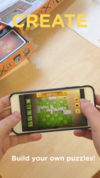
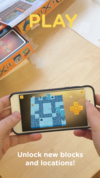
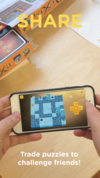
Humans are motivated by many things, including purpose, mastery, accomplishment, social influence and connectedness, ownership, and so on. We tried to make sure that, in our app store images, we highlighted how Puzzle Explorer related to possible player motivations. For example, Puzzle Explorer teaches fundamentals of game design. This relates to motivations like purpose, mastery, and accomplishment. Puzzle Explorer also includes the ability to share your puzzles with friends, which relates to social influence and connectedness. And these are puzzles you have built, which highlights mastery, empowerment, purpose, and accomplishment.
On top of negotiating all these differences between interests, values, player types, and motivations, we we had to negotiate the difference between showing what the game looks like and how it will be interacted with. That is, we needed to show, on the one hand, what the game looks like and, on the other, how a player interacts with it. Relying on screenshots of the game that simply show what the game looks like wouldn’t do justice to Puzzle Explorer. Puzzle Explorer is better represented by showing how kids interact with the game and not by the various screens that they will be interacting with. So, we decided to create images that showed children interacting with the game – creating, playing, sharing, learning, and exploring. This, we realize, can make what the game looks like a little difficult to see and will create complications in the future – for example, we will need to update screenshots as new devices are introduced – but that is a price we are willing to pay to better represent the game.

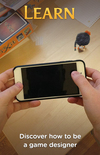

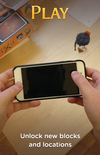

So where are we now? We have drawn up a few wireframes for our proposed app store images (see above) and have sent them along to our friends at Carnevale Interactive, one of the partners working on Puzzle Explorer with us, for some graphic design polish.
[This blogpost originally appeared on www.yeticgi.com]
You May Also Like